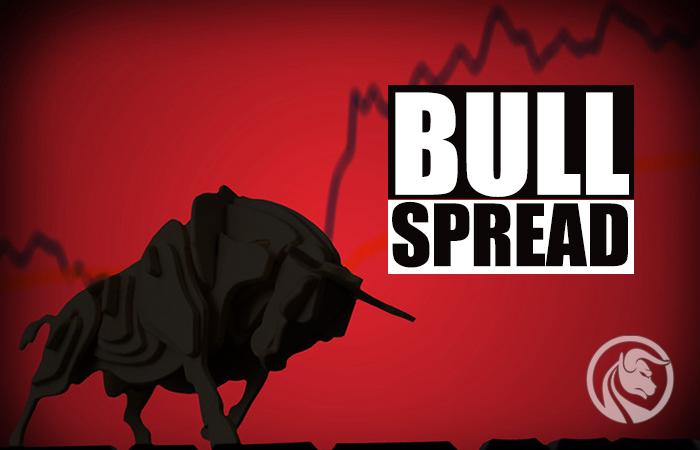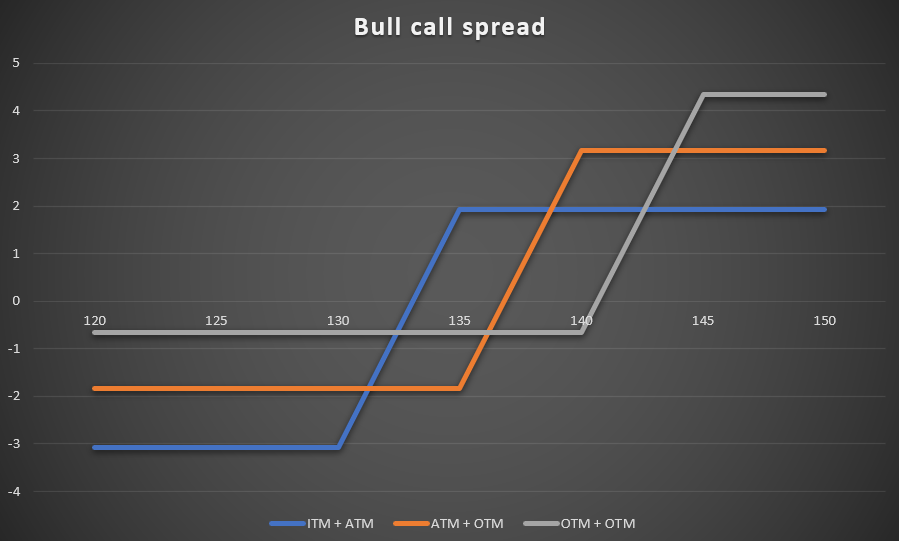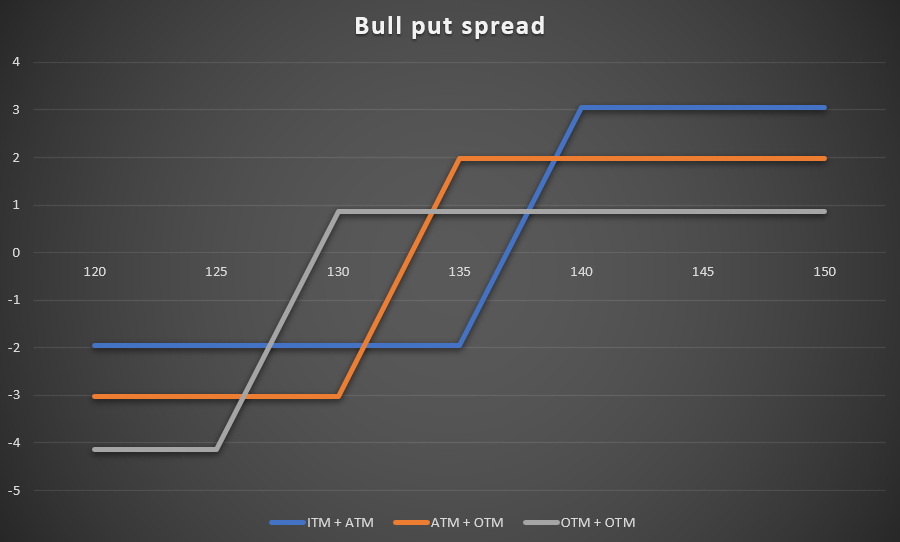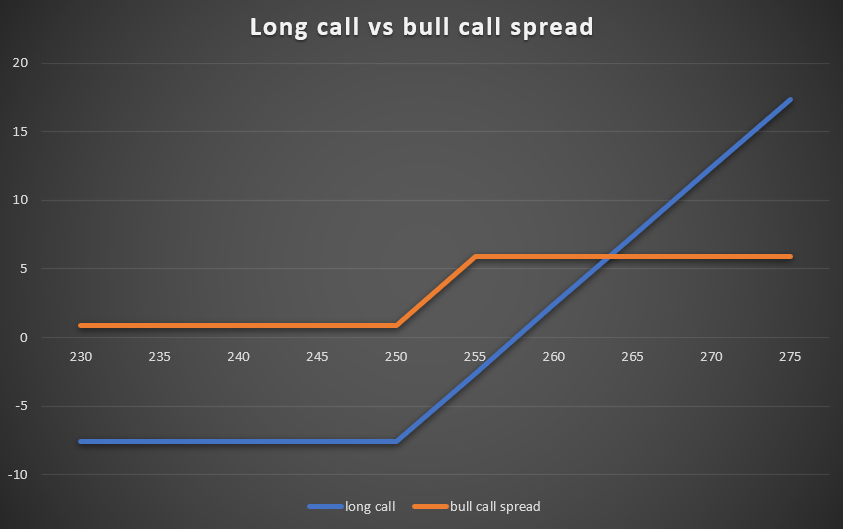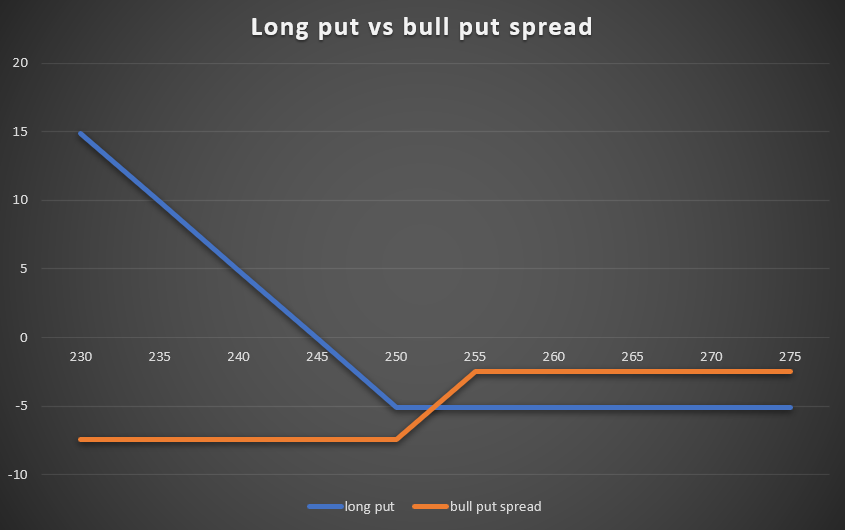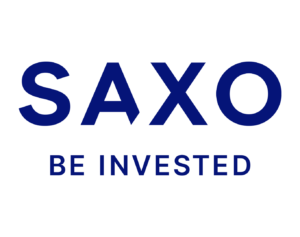Bull Spread - What is the Bull Spread Strategy?
In the previous parts cycle about options the strategies are described married put and covered call. The present article will outline the strategy bull spread (bull spread), which allows you to earn on increases in the prices of indices and stocks.
The bull spread is one of the simplest trading strategies that use options. The bull spread is also one of the most popular spread trades. A typical vertical spread is a strategy that involves simultaneously buying a CALL or PUT option and writing (selling) a CALL or PUT option with a different strike price. Both the purchase and sale of options must be for the same expiry date. In the case of the spread, the bull can be distinguished bull call spread and bull put spread.
Bull Call Spread
In the case of a bull spread using a call option, the strategy is to buy a call option with a lower strike price and at the same time write a call option with a higher strike price. Due to the fact that a call option with a lower strike price has a higher option price than a call option with a higher strike price. As a result, the investor has to "put money". This means that the bull call spread is with a debit option. Writing a call option allows you to reduce the cost of a transaction assuming an increase in the rate.
An example of such a transaction is e.g. assuming a bull call spread on Apple shares on April 23, 2021. For this purpose, you can use call options expiring on June 18, 2021. At the end of the session, the value of one share was $ 134,32. One option gives you exposure to 100 Apple shares. Below is a synthetic table that aggregates the prices of call options just before the session expires:
| The exercise price of the call option | Bid (sale) price | Ask price |
| 110 | 24,30 | 24,45 |
| 120 | 14,40 | 14,55 |
| 130 | 5,60 | 5,70 |
| 135 | 2,63 | 2,67 |
| 140 | 0,83 | 0,86 |
| 145 | 0,21 | 0,23 |
| 150 | 0,07 | 0,09 |
Source: yahoofinance.com
Purchase of ITM options and issuance of ATM options
It is a bull call spread that consists of ITM and ATM options. You can create spread bull by buying a call option with an exercise price of $ 130 and writing an option with an exercise price of $ 135 at the same time. When buying a call option, the investor pays $ 570 ($ 5,7 in bonus multiplied by a multiplier of 100). By issuing a call option, the investor receives $ 263 ($ 2,63 in bonus multiplied by a multiplier of 100). When creating the aforementioned strategy, the trader must pay $ 307 (commission costs omitted). By assuming such a position, the investor has a predetermined level of potential loss, which is equal to the premium paid. Below are the base scenarios:
- Price drop to $ 120
In the event that on the option expiry date the share price drops to $ 120, both options expire worthless. As a result, the investor lost $ 570 and made $ 263. As a result, the loss was $ 307.
- Maintaining the course around $ 135
In a situation where the share price stops around $ 135, the investor loses $ 70 on buying a call option with an exercise price of $ 130 ($ 500 - $ 570). At the same time, the investor made $ 263 as a result of the worthless options written expiring. As a result, the net profit from the transaction was $ 193.
- Price increase to $ 140
If the option expires when the market price of Apple shares reaches $ 140, the investor will make a profit of $ 430 ($ 10- $ 5,7) * 100 from a purchased call share with an exercise price of $ 130. In the case of a written call option, the loss on the transaction will be $ 237 (-$ 500 + $ 263). As a result, the maximum profit was $ 193.
Purchase of an ATM option and issuance of an OTM option
It is a bull call spread that consists of ATM and OTM options. You can create a bull spread by buying a call option with an strike price of $ 135 and simultaneously writing an option with an strike price of $ 140. When buying a call option, the investor pays $ 267 ($ 2,67 in bonus multiplied by a multiplier of 100). When placing a call option, the investor receives $ 83 ($ 0,83 in bonus multiplied by a multiplier of 100). When creating the aforementioned strategy, the trader must pay $ 184 (commission costs omitted). By assuming such a position, the investor has a predetermined level of potential loss, which is equal to the premium paid. Below are the base scenarios:
- Price drop to $ 120
In the event that on the option expiry date the share price drops to $ 120, both options expire worthless. As a result, the investor lost $ 267 and made $ 83. As a result, the loss was $ 184.
- Maintaining the course around $ 135
In a situation where the share price stops around $ 135, the investor loses $ 267 on buying a call option with a strike price of $ 135. At the same time, the investor earned $ 83 as a result of the worthless written options expiring. This gives a net loss on the transaction of $ 184.
- Price increase to $ 140
If the option expires, when the market price of Apple shares is $ 140, the investor will make a profit of $ 233 ($ 5 - $ 2,67) * 100 on a bought call with an exercise price of $ 135. In the case of an issued call option, the profit from the transaction will be $ 83. As a result, the maximum profit was $ 316.
- Price increase to $ 150
The profit on the purchased call option was $ 1 ($ 233 - $ 15) * 2,67. Conversely, writing a call option generated a loss of $ 100 ($ 917 - $ 0,83) * 10. This gives you a net profit of $ 100.
Buying an OTM option and listing an OTM option
This is a bull call spread that is made up of two OTMs. You can create a bull spread by buying a call option with an strike price of $ 140 and writing an option with an strike price of $ 145 at the same time. When buying a call option, the investor pays $ 86 ($ 0,86 in bonus multiplied by a multiplier of 100). By issuing a call option, the investor receives $ 21 ($ 0,21 in bonus multiplied by a multiplier of 100). When creating the aforementioned strategy, the trader must pay $ 65 (commission costs omitted). By assuming such a position, the investor has a predetermined level of potential loss, which is equal to the premium paid. Below are the base scenarios:
- Price drop to $ 120
In the event that on the option expiry date the share price drops to $ 120, both options expire worthless. As a result, the investor lost $ 86 and made $ 21. As a result, the loss was $ 65.
- Price increase to $ 140
This is a similar situation to the previous situation. Both options expire worthless and your net loss is $ 65.
- Maintaining the course around $ 145
In this trade, the trader makes a profit on the purchased call option of $ 414 ($ 5 - $ 0,86) * 100. At the same time, the issued call option expires worthless, which gives a profit of $ 21. As a result, the net profit from the transaction was $ 435.
- Price increase to $ 150
If the price of Apple's stock rises to $ 150 on the day the option is exercised, the investor will make $ 914 of profit on the purchased call option ($ 10 - $ 0,86) * 100. In turn, the issued call option generated a loss of $ 479 ($ 0,21 - $ 5) * 100. The profit on the transaction was $ 435.
Below is a summary of the bull call spread strategy:
| Strategy Summary: | Purchase of ITM (130) + issuance of ATM (135) | Buying an ATM ($ 135) + issuing an OTM ($ 140) | Buying an OTM ($ 140) + issuing an OTM ($ 145) |
| Strategy cost | 307$ | 184$ | 65$ |
| Expiration of $ 120 | - 307 $ | - 184 $ | - 65 $ |
| Score at $ 135 | + 193 $ | - 184 $ | - 65 $ |
| Score at $ 140 | + 193 $ | + 316 $ | - 65 $ |
| Score at $ 150 | + 193 $ | + 316 $ | + 435 $ |
Bull Put Spread
The bull strategy using the PUT option is credit. This means that after the transaction is placed, the investor will receive funds on the account. What it comes from? In order to create the aforementioned strategy, an investor must issue a PUT option with a higher strike price and a purchase of a PUT option with a lower strike price. Due to the fact that the PUT option with a higher strike price has a higher price than the written option. As a result, the investor receives funds on the account after creating the transaction.
An example of such a transaction is e.g. assuming a bull put spread on Apple shares on April 23, 2021. For this purpose, you can use call options expiring on June 18, 2021. At the end of the session, the value of one share was $ 134,32. One option gives you exposure to 100 Apple shares. Below is a synthetic table that aggregates the prices of call options just before the session expires:
| The exercise price of the put option | Bid (sale) price | Ask price |
| 120 | 0,15 | 0,17 |
| 125 | 0,42 | 0,44 |
| 130 | 1,31 | 1,33 |
| 135 | 3,30 | 3,40 |
| 140 | 6,45 | 6,60 |
| 145 | 10,85 | 11,00 |
| 150 | 15,70 | 15,85 |
Source: yahoofinance.com
ITM option issue and ATM option purchase
It is a bull put spread that consists of ITM and ATM options. You can create a bull spread by selling a put option with an strike price of $ 140 and simultaneously buying an option with an strike price of $ 135.
When issuing a put option, the investor pays $ 645 ($ 6,45 bonus multiplied * 100 multiplier). When buying a put option, the investor pays $ 340 ($ 3,40 bonus * 100 multiplier). By creating the aforementioned strategy, the trader receives $ 305, which is the maximum profit. Below are the base scenarios:
- Price drop to $ 120
The investor loses $ 1 ($ 355 - $ 6,45) * 20 on writing an option, which is partially covered by the profit from the put option purchased. The gain on the buy put option was $ 100 ($ 1 - $ 160). As a result, the net loss on the transaction is $ 15.
- Maintaining the course around $ 135
In a situation where the share price stops around $ 135, the investor gains $ 145 on issuing a put option with an exercise price of $ 140 ($ 645 - $ 500). At the same time, the investor lost $ 340 as a result of the expiration of worthless options bought. As a result, the net loss on the transaction was $ 195.
- Price increase to $ 140
Both options expire worthless, which causes the trader to retain the premium that was received as a result of building the bull put spread. The profit from the transaction was $ 305
Issuance of an ATM option and purchase of an OTM option
It is a bull put spread that consists of ATM and OTM options. You can build a bull spread by buying a put option with an strike price of $ 130 and writing an option with an strike price of $ 135 at the same time.
When buying a put option, the trader pays $ 133 ($ 1,33 bonus x 100). By issuing a put option, the investor receives $ 330 ($ 3,30 * a multiplier of 100). By creating the aforementioned strategy, the investor receives $ 197 (commission costs are omitted). The received bonus is the maximum profit. Strategy results from the baseline scenarios:
- Price drop to $ 120
The investor loses $ 1 ($ 170 - $ 3,30) * 15 on writing an option, which is partially covered by the profit from the put option purchased. The gain on the buy put option was $ 100 ($ 867 - $ 10). Consequently, the net loss on the transaction is $ 1,33.
- Maintaining the course around $ 135
Both options expire worthless, which causes the trader to retain the premium that was received as a result of building the bull put spread. The profit from the transaction was $ 197
Buying an OTM option and listing an OTM option
It is a bull put spread that is composed of two OTM options. You can create a bull spread by buying a put option with an strike price of $ 125 and writing an option with an strike price of $ 130 at the same time.
When buying a put option, the trader pays $ 44 ($ 0,44 bonus x 100). When issuing a put option, the trader receives $ 131 ($ 1,31 * 100 multiplier). By creating the aforementioned strategy, the investor receives $ 87 (commission costs omitted). The received bonus is the maximum profit. Strategy results from the baseline scenarios:
- Price drop to $ 120
The investor loses $ 869 ($ 1,31 - $ 10) * 100 on writing an option, which is partially covered by the profit from the put option purchased. The gain on the buy put option was $ 456 ($ 5 - $ 0,44). As a result, the net loss on the transaction is $ 413.
- Maintaining the course around $ 135
Both options expire worthless, causing the trader to retain the premium that was received by building the bull put spread. The profit on the transaction was $ 87
Below is a summary of the bull call spread strategy:
| Strategy Summary: | ITM issuance (140) + ATM purchase (135) | Issuing an ATM ($ 135) + buying OTM ($ 130) | Listing OTM ($ 130) + Buying OTM ($ 125) |
| Bonus received | 305$ | 197$ | 87$ |
| Score at $ 120 | - 195 $ | - 303 $ | - 413 $ |
| Score at $ 130 | - 195 $ | - 303 $ | + 87 $ |
| Score at $ 135 | - 195 $ | + 197 $ | + 87 $ |
| Score at $ 140 | + 305 $ | + 197 $ | + 87 $ |
| Score at $ 150 | + 305 $ | + 197 $ | + 87 $ |
Below is a summary of the Bull Put Spread strategy in graphic form:
Rolling over a profitable position
The bull spread strategy may arise from writing a call option in the case of profitable positions on call options.
To better illustrate this strategy, Microsoft stock options expire on May 7, 2021. On April 5, the investor bought a call option with an exercise price of $ 250. He paid $ 760 ($ 7,6 * multiplier) for it. As of April 23, the option was valued at approximately $ 12,5. As a result, the net profit from the transaction is now $ 490 (12,5-7,6). The closing price for the day was $ 261,6.
The investor is concerned that there will be a decline in shares on Microsoft shares. At the same time, the passage of time will cause the value of the time bonus to drop to zero (about $ 90 bonus).
For this reason, it tries to hedge against potential loss and time decay. To this end, it may issue options expiring on May 7, 2021 at a price of $ 255. With this transaction, the trader receives $ 850 ($ 8,5 in bonus multiplied by the multiplier). Thanks to such a transaction, the investor has already secured the profits from the transaction on Microsoft shares. This is confirmed by the following scenarios:
- Price drop to $ 230
In this case, both options expire worthless. The investor loses $ 760 on the original position and gains $ 850 on the option written. The profit on the transaction is $ 90.
- Price drop to $ 255
An investor loses $ 260 ($ 5 - $ 7,6) * 100 on an option he buys. At the same time, writing the option generated a profit of $ 850. In effect, the net gain from the bull spread below is $ 590.
- Maintaining the course at $ 261,6
The trader earns money when they exercise the purchased option $ 400 ($ 1 - $ 160). At the same time, he earns $ 760 on the option put out ($ 190 - 8,5) * 6,6. The total net profit is $ 100.
- Price increase to $ 265
As the Microsoft exchange rate increases to $ 265, the investor earns $ 740 from the purchased option. On the other hand, the investor loses $ 150 on the issued call option. As a result, the maximum was $ 590.
When a call option is written, a bull call spread will arise. In this case, it is a defensive strategy that protects the investor against a decline in Microsoft's exchange rate. In the case of a negative scenario, the investor finishes the strategy with a profit of $ 90. The "cost" of the strategy is to come to terms with a maximum profit of $ 590.
Rolling over a losing position
A bull spread strategy may arise from writing a put option in order to reduce the potential loss from a purchased put option.
To better illustrate this strategy, Microsoft stock options expire on May 7, 2021. On April 8, an investor bought a put option with an exercise price of $ 250. He paid $ 510 ($ 5,1 * multiplier) for it. As of April 23, the option was trading at around $ 1,7. As a result, the net loss on the transaction is now $ 340 (1,7-5,1). The closing price for the day was $ 261,6.
The investor is concerned that the Microsoft stock will not fall below $ 245. At the same time, the passage of time will cause the value of the time bonus ($ 170 bonus) to drop to zero.
For this reason, the investor will try to protect against losing the total capital. For this purpose, it may issue put options expiring on May 7, 2021 at a price of $ 255. With this transaction, the trader receives $ 265 ($ 2,65 in bonus multiplied by the multiplier).
- Price drop to $ 230
In this case, the positive scenario comes true. The investor generates $ 1 of profit on the put option purchased. At the same time, it loses $ 490 on the put option. This results in a net loss of $ 2. The loss is $ 235 greater than the underlying strategy.
- Price drop to $ 255
An investor loses $ 510 ($ 0 - $ 5,1) * 100 on an option he buys. At the same time, writing the option generated a profit of $ 265. Consequently, the net loss from the bull spread below is $ 245. As a result, the net loss was reduced by the value of the issued put option.
- Maintaining the course at $ 261,6
Both options expire worthless, resulting in a net loss on the transaction of $ 245.
The bull put spread strategy can be used as a transaction to minimize losses on a purchased put option in the event of an increase or maintenance of the share price. The downside to this strategy is the increase in trade loss as Microsoft shares fall below $ 252,35. The greater the drop, the greater the difference between the result of the long put strategy and the bull put spread. For this reason, such a strategy can only be used in situations where the trader is expecting a sideways or uptrend.
Do you know that…?
Saxo Bank is one of the few Forex brokers that offers vanilla options. The investor has a total of over 1200 options at his disposal (currencies, stocks, indices, interest rates, raw materials). CHECK
Summation
Using the bull spread strategy can be a very interesting alternative to simply buying a call option or writing a put option. At the same time, the formation of a bull spread may arise as a result of defense strategies for prior strategies.
The bull spread can be used in the following situations:
- Reduce transaction costs on options (compared to regular long call)
- Minimizing the impact of "time decay"
- rolling profitable transactions
- rolling over losing trades






















![Forex Club – Tax 9 – Settle tax on a foreign broker [Download the Application] Forex Club - Tax 9](https://forexclub.pl/wp-content/uploads/2024/02/Forex-Club-Podatek-9-184x120.jpg?v=1709046278)
![Trading View platform – solutions tailored to the needs of traders [Review] trading view review](https://forexclub.pl/wp-content/uploads/2024/03/trading-view-recenzja-184x120.jpg?v=1709558918)
![How to connect your FP Markets account to the Trading View platform [Guide] fp markets trading view](https://forexclub.pl/wp-content/uploads/2024/02/fp-markets-trading-view-184x120.jpg?v=1708677291)
![How to invest in ChatGPT and AI? Stocks and ETFs [Guide] how to invest in chatgpt and artificial intelligence](https://forexclub.pl/wp-content/uploads/2023/02/jak-inwestowac-w-chatgpt-i-sztuczna-inteligencje-184x120.jpg?v=1676364263)


![WeWork – the anatomy of the collapse of a company valued at $47 billion [WeWork, part II] wework bankruptcy story](https://forexclub.pl/wp-content/uploads/2024/04/wework-bankructwo-historia-184x120.jpg?v=1711729561)
![Adam Neumann – the man who screwed up Softbank [WeWork, part AND] adam neumann wework](https://forexclub.pl/wp-content/uploads/2024/04/adam-neumann-wework-184x120.jpg?v=1711728724)





![How to transfer shares to another brokerage office [Procedure description] how to transfer shares to another brokerage house](https://forexclub.pl/wp-content/uploads/2024/03/jak-przeniesc-akcje-do-innego-biura-maklerskiego-184x120.jpg?v=1709556924)

![The most common mistakes of a beginner trader - Mr Yogi [VIDEO] Scalping - The most common mistakes of a beginner trader - VIDEO](https://forexclub.pl/wp-content/uploads/2024/03/Scalping-Najczestsze-bledy-poczatkujacego-tradera-VIDEO-184x120.jpg?v=1711601376)
![Learning patience: No position is also a position - Mr Yogi [VIDEO] Scalping - Learning patience - No position is also a position - VIDEO](https://forexclub.pl/wp-content/uploads/2024/03/Scalping-Nauka-cierpliwosci-Brak-pozycji-to-tez-pozycja-VIDEO-184x120.jpg?v=1710999249)
![When to exit a position and how to minimize losses - Mr Yogi [VIDEO] Scalping - When to exit a position and how to minimize losses - VIDEO](https://forexclub.pl/wp-content/uploads/2024/03/Scalping-Kiedy-wyjsc-z-pozycji-i-jak-minimalizowac-straty-VIDEO-184x120.jpg?v=1710336731)


